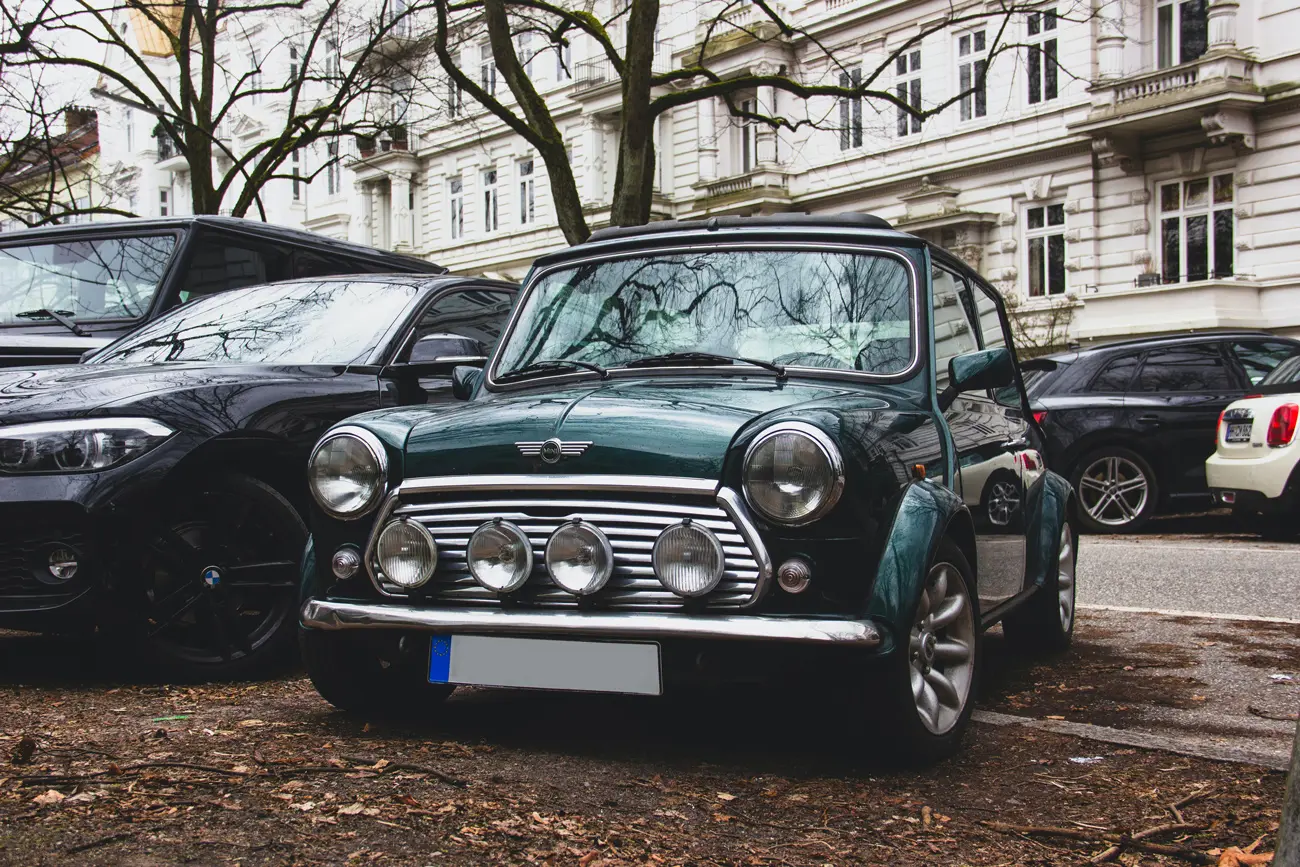
Alert text here. Lorem ipsum dolor sit amet consectetur. Commodo tincidunt tincidunt maruis. HyperLink here

Alert text here. Lorem ipsum dolor sit amet consectetur. Commodo tincidunt tincidunt maruis. HyperLink here
09 April 2021
Few cars prompt such joyful reactions from drivers as the magnificent Mini. Chock full of personality and incredibly fun to drive, the Austin version of the Mini – initially called the Se7en – is an icon of British automotive engineering.
Launched in 1959, it’s gone on to become the ultimate classic car in many ways, capturing the hearts and the minds of the nation – so much so that it remained relatively unchanged for more than 40 years.
A big selling point of the Mini was its revolutionary space-saving transverse engine and front-wheel drive layout, which meant that 80% of the car’s floor plan could be given over to passengers and their luggage. In 1999, the Mini was voted the second-most influential car of the 20th century.
If you’re a Mini owner – or thinking about going into the classic car market for one – don’t forget to take out suitable classic car insurance that will help protect your investment for the future.
Insurance for your classic car gives you the reassurance you need to go and enjoy your Mini exactly as it was intended.
As a Mini enthusiast, you might think you know all there is to know about the British’s people’s car. But, put your knowledge to the test with these ten fast facts about this brilliant British icon.
That’s correct, the idea for the original Mini was spawned off the back of the Suez crisis in the mid-50s.
The Suez crisis is the name given to the invasion of Egypt by the trio of Israel, the United Kingdom and France with intentions to regain the Suez Canal.
At that time, the Canal was an important shipping route for oil from the middle east and, due to the Suez crisis, shipments were blocked.
With a shortage of oil being shipped to the West, petrol was rationed in the UK and other parts of Europe, and many people started to look for more fuel-efficient cars. Sales in larger cars took a hit as smaller European cars – such as the Fiat 500 – became more and more popular.
Sir Leonard Lord, who was the head of the British Motor Corporation at the time, didn’t like the idea of British people buying cars that weren’t made on UK shores and set out to make a 'proper' miniature car.
After outlining his plans, he put designer Alec Issigonis – who had already given the UK the Morris Minor – on the job.
Issigonis managed to create a fun, affordable, economical design with superior handling that fitted four people, which would later be known as the Mini, and it was put into production in July 1957.

You only need to look at the Mini to see that it’s not exactly the safest set of wheels to be in should you be involved in a crash.
But this wasn’t given much thought at the time, with the size and affordability of the car taking priority.
And talking of size, did you know the Mini missed its 10 feet dimension specified by Sir Lord by a quarter of an inch? Even so, you can still squeeze an amazing 27 people into one of the classic designs, according to the Guiness Book of World Records.
And if you’re talking about the newer BMW Mini, that can hold one better at 28!
Thankfully, the original Mini’s safety elements improved in later models when airbags and side impact bars were made standard across the range.
Issigonis actually thought the original Mini would be too fast for the motorist of 1959 to handle and so reduced the power of the engine to 850cc.
Despite this, in the hands of a capable driver, it still offered a super-speedy ride.
As well as being an iconic design in its own right, the Mini also made an impact on the world of fashion. Mary Quant looked to the diminutive motor for inspiration for her famous mini skirts! She took the name and made another British icon – well done that woman!
In the late 1970s, it looked like the Mini might have had its day. Having been in production for 20 or so years without too many alterations, it was starting to feel a bit tired and outclassed by modern rivals.
The Mini’s ‘replacement’ came out in 1980 in the shape of the Austin Mini Metro, which promised to retain all the elements of the original Mini that people loved, but with a modern twist.
The car was fairly pioneering in itself, being one of the earliest production cars to use gas suspension. Critics were won over, with the car winning What Car? Car of the Year twice!
It was popular with the British public, too, with the Mini Metro in production for 18 years, selling more than two million units. But its popularity started to dwindle in the early to mid-1990s, with production ceasing in 1997 following a poor crash rating and sales falling.
At the same time that Mini Metro was having its moment, the Mini was enjoying a turnaround in its fortunes thanks to special editions and a new-found love for the now classic car.
Although the original Mini never stopped being popular, selling well into the late 1990s, production came to a natural end just after the Millennium due to ever-tightening European safety and emissions regulations.
Thankfully, you don’t have to go too far to see a Mini on the road today – unlike the Metro which is a rare sight these days.

While the Mini sold well throughout Europe and other parts of the world, just 10,000 or so left-hand drive Minis were exported to the United States from 1960 to 1967.
Then, in 1968, tough emissions and safety laws in the US – somewhat unsurprisingly – prompted the Mini to be discontinued in the region. It did, however, remain on sale in Canada until 1980.
The US has never made it easy for British cars to make it big in the region – and things got even tougher in 1988 when a law was introduced which means that there is a 25-year waiting period before a car can be imported and registered for use.
Nowadays, cars that are new off the production line can be transported in large vehicle carriers – but they were few and far between back in the 50s and 60s.
That meant each Mini had to be driven to its destination by a delivery driver – but it wasn’t always the best job, despite the Mini being generally fun to drive.
When the Mini first rolled off the factory floor, it had a less than reliable record when it came to weather sealing – water used to creep its way into the cabin on wet days and then start to pool, leaving drivers with wet feet.
Just to be clear, it was only the delivery drivers which had to put up with this – once the cars arrived at the garage they were dried out and re-sealed to a much higher standard.
For the delivery driver, however, it often meant putting the carpets in the back and driving in a pair of wellies! Thankfully this issue was put right on subsequent models.
The Lamborghini Miura is considered to be one of the most beautiful cars ever made. In fact, we’ve extolled the car’s beauty a couple of times on our blog. However, it might not ever have come into existence if the Mini hadn’t come before it.
Many car enthusiasts will know that the Mini had a transversely mounted engine (in simple terms, its mounted sideways) which is one of the reasons the Mini was able to be so compact.
The transverse engine was in existence a little while before the Mini was invented – but designer Issigonis and his team perfected it.
The designer of the Miura is said to have been mightily impressed by this particular aspect of Mini and took inspiration from the transverse engine that had a common crank case for both the engine and transmission.
Just like the Mini, the Miura broke ground in the industry, becoming the first mid-engine road car ever produced, and one of the few to use a transverse mounted V12.

The Mini was never built to be a race car – the intention was for it to be a practical, fuel efficient car for the family. But race teams recognised that it had potential to be a force on the track, thanks to its lightweight build and responsive steering.
It wasn’t long before specially prepared Minis were competing in races – and it quickly won titles.
The Mini claimed the title at the 1964,1965 and 1967 Monte Carlo Rally. Many believe it should have made it four years in a row, but it was disqualified at the 1966 event for a lightbulb infringement.
It was a highly contentious decision, with the British Motor Corporation threatening to withdraw its participation in the rally.
After the race, a British official said: "This will be the end of the Monte Carlo rally. Britain is certain to withdraw." Alas, it didn’t and the Mini went on to win the race the year after.
The Mini’s racing record was remarkable with wins in the British Rally Championship three times, the European Rally Championship twice and the European Touring Car Championship, to name but a few. It really was a pocket rocket!
Imagine being asked to design your own Mini! What would yours look like? In 1998, that’s exactly what the Rover Group asked artists from the worlds of fashion and music, including Paul Smith, Kate Moss and David Bowie in order to mark the car’s birthday celebrations the following year.
Smith and Moss played things fairly safe, opting for coloured stripes and a spider’s web set against a dark paint finish respectively. But Bowie, as he always did, took a more left-field approach.
Here’s how the BMW Group described Bowie’s design: “Like a highly-polished silver bar reflecting everything around it and with not a single window you could see through from the outside. Only the rear lights and tyres remained untouched, as the car had to be driveable – in theory at least.”
Bowie said he wanted to create a Mini that “could not be distinguished from its surroundings”. He also liked the idea that anybody who saw the car would also be looking at their own face, thereby becoming part of the Mini.
When asked why he thought the Mini’s design endured for more than 40 years, Bowie simply said: parking. He wasn’t wrong – although there is probably more to it than that, in truth. But it got to the heart of why the Mini was built: for city dwellers.
Did you know that Issigonis did away with the radio in the original design of the Mini to make way for an ashtray? Apparently he was quite a big smoker at the time. And who wants to listen to music when you can listen to that engine growling away anyway?
Plus the door pockets were made big enough to accommodate a bottle of Gordon’s gin!
If you’re lucky enough to drive or own a Austin Mini – or any classic for that matter – you’re going to need specialist classic car insurance.
If you have a rare classic hiding in your barn and you’re wondering how much it’s worth, Lancaster can organise a two-year agreed valuation for just £18 a year.
Like you, the team at Lancaster is passionate about classic cars. We can offer cover for static shows, historical rallies, restoration projects and more.
Limited mileage discounts are also available if your classic only comes out on very special occasions.
Policy benefits, features and discounts offered may very between insurance schemes or cover selected and are subject to underwriting criteria. Information contained within this article is accurate at the time of publishing but may be subject to change.